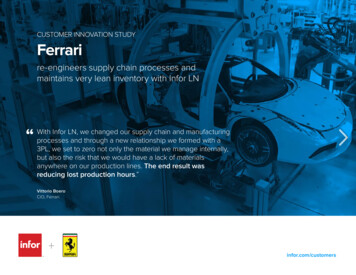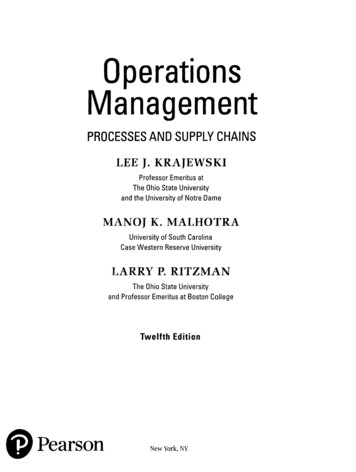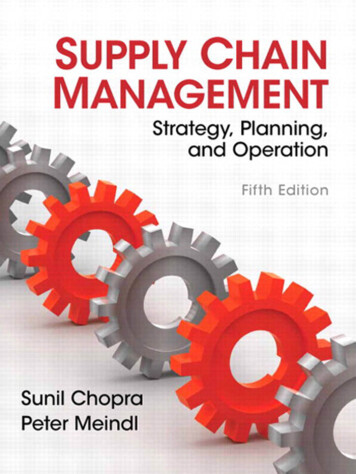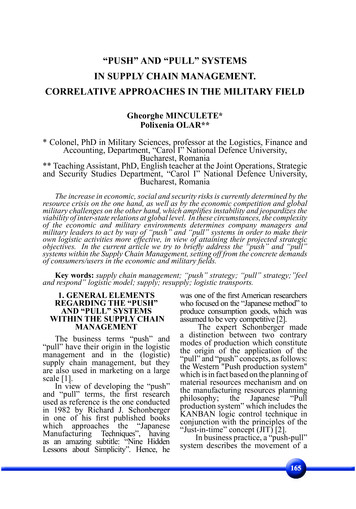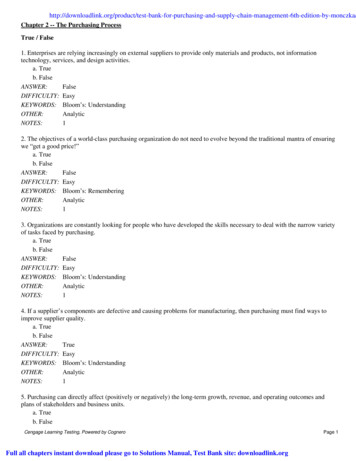
Transcription
The Supply Chain ManagementProcessesKeely L. Croxton, Sebastián J. García-Dastugue and Douglas M. LambertThe Ohio State UniversityDale S. RogersUniversity of Nevada, RenoIncreasingly, supply chain management is being recognized as the management ofkey business processes across the network of organizations that comprise thesupply chain. While many have recognized the benefits of a process approach tomanaging the business and the supply chain, most are vague about whatprocesses are to be considered, what sub-processes and activities are containedin each process, and how the processes interact with each other and with thetraditional functional silos. In this paper, we provide strategic and operationaldescriptions of each of the eight supply chain processes identified by members ofThe Global Supply Chain Forum, as well as illustrations of the interfaces among theprocesses and an example of how a process approach can be implemented withinan organization. Our aim is to provide managers with a framework to be used inimplementing supply chain management, instructors with material useful instructuring a supply chain management course, and researchers with a set ofopportunities for further development of the field.“Streamlining crosscompany processes isthe next great frontierfor reducing costs,enhancing quality, andspeeding operations”.Volume 12, Number 22001Supplychainmanagementisincreasingly being recognized as theintegration of key business processes acrossthe supply chain. For example, Hammerargues that now that companies haveimplemented processes within the firm, theyneed to integrate them between firms:Streamliningcross-companyprocesses is the next great frontierfor reducing costs, enhancingquality, and speeding operations. Itis where this decade’s productivitywars will be fought. The victors willbe those companies that are able totake a new approach to business,working closely with partners todesign and manage processes thatextend across traditional corporateboundaries. They will be the onesthat make the leap from efficiencyto super efficiency [1].Monczka and Morgan also focus on theimportance of process integration in supplychain management [2]. The piece that seemsto be missing from the literature is acomprehensive definition of the processesthat constitute supply chain management.How can companies achieve supply chainintegration if there is not a commonunderstanding of the key business processes?It seems that in order to build links betweensupply chain members it is necessary forcompanies to implement a standard set ofsupply chain processes. Practitioners andeducators need a common definition ofsupply chain management, and a sharedunderstanding of the processes.We recommend the definition of supplychain management developed and used byThe Global Supply Chain Forum:Supply Chain Management is theintegration of key businessprocesses from end user throughoriginal suppliers that providesproducts, services, and informationthat add value for customers andother stakeholders [3].The Forum members identified eight keyprocesses that need to be implemented withinand across firms in the supply chain. To date,Page 13
the published descriptions of these processeswere limited to one-paragraph summariesthat provide little guidance on how toimplement a process approach [4]. Ourpurpose in this paper is to provide more detailon the sub-processes and activities thatcomprise the supply chain processes. Thegoal is to provide management withguidelines to help with implementation,instructors with material for structuring asupply chain management course andresearchers with a detailed framework forfuture research on supply chain management.The paper is organized as follows. First,there is a brief review of the supply chainframework. Next, there is a section on each ofthe eight processes. This is followed by a sectionon implementation. Finally, opportunities forfuture research and conclusions are presented.Supply Chain ManagementThe Global Supply Chain Forumidentified eight key processes that make upthe core of supply chain management [5]: Customer Relationship Management Customer Service Management Demand Management Order Fulfillment Manufacturing Flow Management Procurement Product Development and Commercialization Returns.The term “procurement” is a source ofconfusion. Novak and Simco highlight theconfusion by citing studies in whichprocurement is defined as “.the act ofbuying. all those activities necessary toacquire goods and services consistent withuser requirements” [6]. Other authors usesimilar definitions [7].Because thesedefinitions do not adequately represent ourview of the supply chain process, we haverenamed the procurement process “supplierrelationship management”. Also, for furtherclarification we have changed the name ofthe returns process to returns management.The eight key business processes run thelength of the supply chain and cut acrossfirms and functional silos within each firm(see Figure 1). Functional silos includeMarketing, Research and Development,Finance, Production, Purchasing andLogistics. Activities in these processes resideinside a functional silo, but an entire processwill not be contained within one function.Our purpose in thispaper is to provide moredetail on the subprocesses and activitiesthat comprise the supplychain processes.Figure 1Supply Chain Management:Integrating and Managing Business Processes Across the Supply ChainInformation FlowTier 2SupplierManufacturerTier ngPurchasingPRODUCTION FLOWProductionSupply Chain Business ProcessesR&DFinanceCUSTOMER RELATIONSHIP MANAGEMENTCUSTOMER SERVICE MANAGEMENTDEMAND MANAGEMENTORDER FULFILLMENTMANUFACTURING FLOW MANAGEMENTSUPPLIER RELATIONSHIP MANAGEMENTPRODUCT DEVELOPMENT AND COMMERCIALIZATIONRETURNS MANAGEMENTSource: Adapted from Douglas M. Lambert, Martha C. Cooper, and Janus D. Pagh, “Supply Chain Management: ImplementationIssues and Research Opportunities,” The International Journal of Logistics Management, Vol. 9, No. 2 (1998), p. 2.Page 14The International Journal of Logistics Management
The customer relationshipmanagement processprovides the structure forhow the relationship withthe customer is developedand maintained.While management of all firms ineach supply chain should consider theseeight processes, the relative importanceof each process and the specificactivities included may vary. The subprocesses and activities we describeare designed from the perspective ofa manufacturing company sitting nearthe middle of the supply chain (see Figure 1).Each process is described at strategicand operational levels.The strategicportion consists of the establishmentand strategic management of each process,and provides a blueprint for implementation.This is a necessary first step in integratingthe firm with other members of thesupply chain. The operational portion is theactualization of the process once it hasbeen established.Next, we will describe the sub-processesand activities that make up each of the eightprocesses as well as the interactions betweenprocesses, functions, and key members of thesupply chain. The description of each processis accompanied by a figure that illustrates thesub-processes and the interfaces between theprocesses.Customer Relationship ManagementThe customer relationship managementprocess provides the structure for how therelationship with the customer is developedand maintained. Management identifies keycustomers and customer groups to be targetedas part of the firm’s business mission [8].Customer teams tailor Product and ServiceAgreements (PSA) to meet the needs of keyaccounts and segments of other customers [9].Teams work with key accounts to improveprocesses, and eliminate demand variabilityand non-value-added activities. Performancereports are designed to measure theprofitability of individual customers as well asthe firm’s financial impact on those customers.The Strategic ProcessAt the strategic level, the customerrelationship management process providesthe framework for managing relationshipswith customers, and is comprised of five subprocesses (see Figure 2). In the first, theprocess team reviews the corporate andmarketing strategies to identify customersegments that are key to the organization’ssuccess now and in the future.Figure 2Customer Relationship ManagementStrategic Sub-ProcessesReview Corporate andMarketing StrategyProcesses InterfacesOperational Sub-ProcessesCustomerService ManagementDifferentiate CustomersDemandManagementPrepare the Account/SegmentManagement TeamOrder FulfillmentInternally Review the AccountsManufacturing FlowManagementIdentify Opportunities with theAccountsSupplier RelationshipManagementDevelop the Product/Service AgreementProduct Development& CommercializationImplement the Product/ServiceAgreementReturns ManagementMeasure Performance andGenerate Profitability ReportsIdentify Criteria forCategorizing CustomersProvide Guidelines for theDegree of Differentiation in theProduct/Service AgreementDevelop Frameworkof MetricsDevelop Guidelines for SharingProcess Improvement Benefitswith CustomersVolume 12, Number 22001Page 15
Next, the team identifies the criteria forcategorizing customers and providesguidelines for determining which customersqualify for tailored PSAs and which customerswill be grouped into segments and offered astandard PSA that is developed to providevalue to the segment. Potential criteriainclude: profitability, growth potential,competitive positioning issues, access tomarket knowledge, market share goals, marginlevels, level of technology, resources andcapabilities, compatibility of strategies, andchannel of distribution. As part of this subprocess, the team develops the firm’s strategyfor dealing with segments of customers whodo not qualify for individually tailored PSAs.In the third sub-process, the teamdevelops guidelines for the degree ofdifferentiation in the PSA. This involvesdeveloping the differentiation alternatives andconsidering the revenue and cost implicationsof each. The output is the degree ofcustomization that can be offered tocustomers. The goal is to offer PSAs thatenhance the profitability of the firm and thecustomers. To find and understand thedifferentiation opportunities, this sub-processwill interface with all of the other processes.Developing the framework of metricsinvolves outlining the metrics of interest andrelating them to the customer’s impact on thefirm’s profitability as well as the firm’s impacton the customer’s profitability. The customerrelationship management process has theresponsibility for assuring that the metrics usedto measure all of the other processes are notconflicting. Management needs to insure thatall internal and external measures are drivingconsistent and appropriate behavior [10].In the final sub-process, the teamdevelops the guidelines for sharing processimprovement benefits with customers. Thegoal is to make these process improvementswin-win solutions for both the firm and thecustomer.In summary, the objective of customerrelationship management at the strategic levelis to identify customer segments, providecriteria for categorizing customers, providecustomer teams with guidelines forcustomizing the product and service offering,develop a framework for metrics, and provideguidelines for the sharing of processimprovement benefits with the customers.Page 16The Operational ProcessAt the operational level, the customerrelationship management process deals withwriting and implementing the PSAs. It iscomprised of seven sub-processes. First,customers are differentiated based on thecriteria developed at the strategic level. Keycustomers are identified and other customersare grouped into customer segments.Next, the account or segmentmanagement teams are formed, including thesalesperson who will be the account orsegment manager. The teams are crossfunctional with representation from each ofthe functional areas. In the case of keyaccounts, each team is dedicated to a specificaccount and meets regularly with thecustomer. In the case of customer segments,a team manages a group of customers anddevelops and manages the standard PSA forthe segment.Each account team reviews theiraccount or segment of accounts to determinethe products purchased, sales growth andtheir position in the industry. Once theteam has an understanding of the customer(s),they work with each account or segmentof accounts to develop improvementopportunities in sales, costs and service. Theseopportunities might arise anywhere, so theaccount teams need to interface with each ofthe other processes.In the fifth sub-process, each teamdevelops the PSA for their account or segmentof accounts. This team first outlines and draftsthe PSA, and then gains commitment from theinternal functions. For key accounts, theypresent the PSA for acceptance, and workwith the customer until agreement has beenreached. It is important that the PSAs for keyaccounts include a communication andcontinuous improvement plan. For otheraccounts, the PSA is presented to thecustomer.In the sixth sub-process, the teamimplements the PSA, including regularmeetings with key customers. At this point,input is provided to each of the otherprocesses that are affected by thecustomizations in the PSA.In the last operational sub-process, theteam captures and reports the processperformance measures. Metrics from each ofthe other processes also are captured in orderAt the operational level,the customer relationshipmanagement processdeals with writing andimplementing the PSAs.The International Journal of Logistics Management
to generate the customer profitabilityreports. These profitability reports provideinformation for measuring and selling thevalue of the relationship to each customer andinternally to upper management. The valueprovided should be measured in terms ofcosts, impact on sales, and associatedinvestment, otherwise the efforts incurred willgo unrewarded [11].Cu
Increasingly, supply chain management is being recognized as the management of key business processes across the network of organizations that comprise the supply chain. While many have recognized the benefits of a process approach to managing the business and the supply chain, most are vague about what processes are to be considered, what sub-processes and activities are contained in

